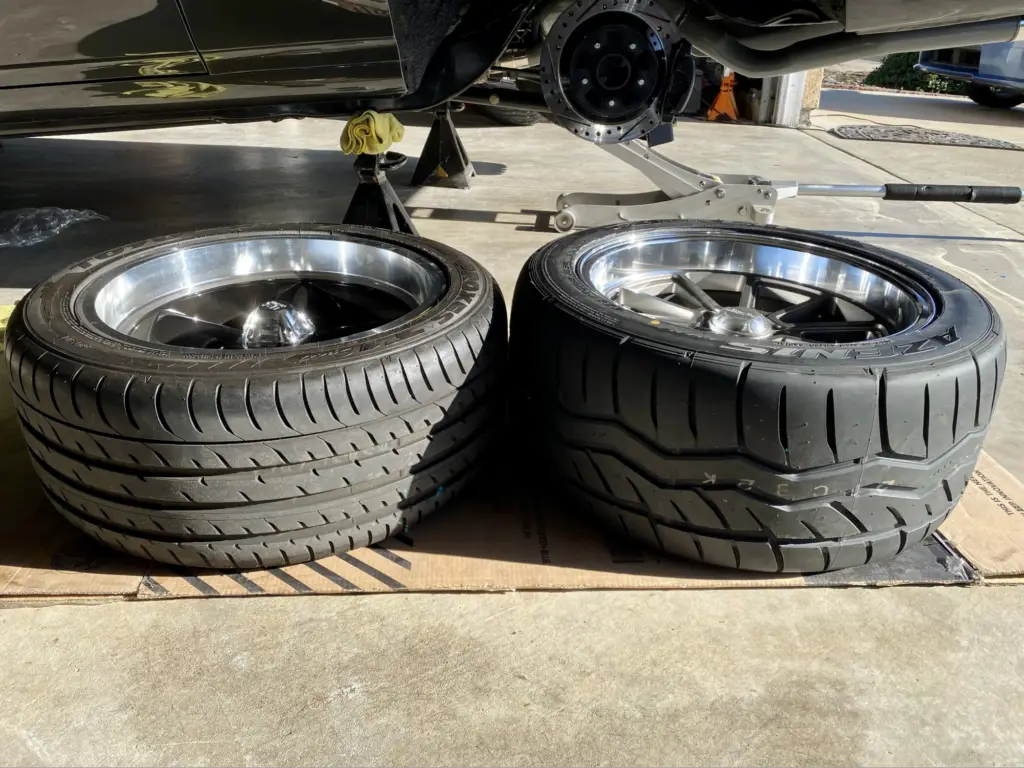40 Series Tires feature 40% of the tire’s section width with better braking, rigid handling, and fuel economy. On the other hand, 45 Series Tires have 45% of the tire’s section width with less rigid handling, fine braking, and higher rolling resistance. Then, 40 series tires deflate more quickly and reduce traction than 45 series tires.
Moreover, 40-series tires reduce the gap between your car and the road, transferring road irregularities directly to your suspension.
This is just a sneak peek. A description of the differences between 40 and 45 series tires is necessary for users. So, hang tight with the article to know all of them in a detailed manner.
Difference between 40 and 45 Series Tires: A Quick Overview
40 and 45 series tires possess some significant differences. Before discussing the differences in detail, let’s have a glimpse of them.
| Differences | 40 series Tires | 45 series tires |
| Sidewall height | 40% of the tire’s section width | 45% of the tire’s section width |
| Handling | More rigid | Relatively less rigid |
| Braking | Finest | Fine |
| Fuel economy | Less resistance | More resistance |
| Rolling resistance | Less | Higher |
| Clearance & road impact | Less | More |
| Deflation | More quickly | Take some time |
| Traction on uneven terrain | More reduction of traction | Less reduction |
| Prices | Relatively cheaper | More pricy |
Now, let’s move to the important section. It’s time to discuss the differences in a comprehensive manner so that the users can gain enough knowledge of both of them.

Sidewall Height:
The 40 and 45 series tires are one of the most popular low-profile tires you will likely come across while shopping for tires. A 40 series tire means that the tire size’s sidewall height (from the rim to the tread) is 40% of its section width.
So, on a set of tires that is 295 mm wide, a 40 series tire would have a 118mm tall sidewall. The measurement is the tire’s section height, also referred to as the tire’s aspect ratio or profile. So, in other terms, a 40 series tire can also be referred to as a tire with an aspect ratio of 40.
On the other hand, a 45 series tire means that the tire’s sidewall height is 45% of its section width. So on a set of tires that is 295mm wide, a 45 series tire would have a 133mm tall sidewall. 45 series tires have an aspect ratio of 45.
Handling:
The sidewalls of the 40 series tires are more rigid than those of the 45 series tires. And they feature more significant contact areas, traction on smooth surfaces, and wheel response.
The more wide a tire is, the more it can provide grip and traction handling. For example, if you compare 225 tires with 205, the 225 will offer you better handling performance.
So, compared to the 45 series tire, the 40 series tires are faster and more effective.
Braking:
In terms of braking, the 40 series are the finest. This is because larger rims are required to make up for the fact that the tires themselves take up less area. This thus makes it possible to add larger braking hardware.
More extensive hardware results in greater stopping power, which might be crucial while traveling at higher speeds.
Fuel Economy:
The 40 series tires roll with less resistance than the 45 series tires because they have short, rigid sidewalls and simple tread designs. Better fuel efficiency is a result of lower rolling resistance. Therefore the 40 series have better fuel economy than the 45 series tires.
Rolling Resistance:
Opting for 40 series tires over 45 series tires ensures lower rolling resistance. That enhances fuel efficiency due to their short, rigid sidewalls and straightforward tread designs. This choice provides better steering response and control, making them suitable for performance and sporty aesthetics.
Conversely, 45 series tires prioritize comfort, durability, and fuel efficiency. That offers a smoother ride for those seeking comfort over enhanced performance.
Clearance & Road Impact:
Running 40-series tires rather than 45-series tires results in a smaller gap between your car and the road. The shock of the numerous road irregularities is then transferred to your suspension system.
You’re safe if your suspension system is set up to accommodate low-profile tires. If not, though, you run the risk of not just experiencing a loud, rough ride but experiencing some significant damage. Although this will be more noticeable with the 40 series tires, it could also occur if you use the 45 series tires.

Deflation:
The 40 series tires will deflate more quickly if a flat occurs than the 45 series tires. The tires need less air because they are thin; therefore, less air will leak out if they are punctured.
Wheel Damage:
There is significantly less cushion between your wheels and rims and the road when using 40-series tires compared to the 45-series. When using 40 series tires, hitting a pothole might cause major wheel problems, tire punctures, or even bending of the rims.
Traction on Uneven Terrain:
Compared to the 45 series tires, the 40 series tires have poorer traction over irregular surfaces. This type of difference you’ll see in 295 and 33 tires.
It happens when there’s a size difference between the two tires. Also, the characteristics from the “Handling” segment, play a vital role here.
Prices:
Compared to the 40 series tires, the 45 series tires cost more. However, the difference in prices isn’t too significant.
The cost of 40 series tires is contingent on the type and brand. Pro-Line 40 Series Masher Tires 3.8″ at $25.00, RC4WD Mud Slingers Monster Size 40 Series Tires ranging from $41.99 to $46.98.
And MT 40 Series 3.8″ Wheels/Tires are priced between $59.99 and $61.99.
The price of 45 series tires fluctuates based on the particular tire and brand. Examples include the Goodyear Eagle Touring All-Season Radial Tire (285/45R22 114H) at $166.97, and the Summit Ultramax HP All-Season Tire (235/45R18 98V) at $78.96. The Continental ProContact TX All Season (245/45R18 96V) Passenger Tire is priced at $205.07.
40 vs. 45 Series Tires: Which One Should You Go For?
Both of these tires perform admirably. However, the 45 series tire tends to be meatier when compared to the 40 series tire. For this reason, the 45 series tire will offer a smooth ride compared to the 40 series tires.
Another thing to consider when shopping for these two tires is their prices. Compared to the 40-series tire, the 45-series tire is cheaper.
In terms of handling, appearance, fuel efficiency, and braking, the 40 series tires take the lead.
Frequently Asked Questions (FAQs):
What are Low-Profile Tires?
Low-profile tires, characterized by an aspect ratio (profiles) of 55% or less, feature shorter sidewalls than regular tires. They typically serve as street performance options, including performance all-season, summer, and ultra-high performance tires.
Are 40 and 45 Series Tires Low-Profile Tires?
The 40 and 45 series tires have an aspect ratio of 40 and 45, respectively. These tires can be considered low-profile tires since low-profile tires are tires with an aspect ratio of 55 or less.
What are the Advantages of Low Profile Tires?
Low-profile tires offer enhanced handling, better braking, increased fuel efficiency, and a better appearance than standard tires.
What are the Disadvantages of Using 40 and 45 Series Tires Over the Standard Tires?
Compared to the regular tires, the 40 and 45 series tires will offer you a bumpier ride, poor grip on irregular surfaces, less protection for your wheels, and deflate rapidly in case of a puncture.
What are the Main Tire Types Available?
Three main tire types are available; summer, winter, and all-season tires. Many people purchase all-season tires because it is cheaper than buying one set for summer and another for winter.
Final Take
We hope this article has given you all you need to know about the difference between 40 vs 45 series tires.
